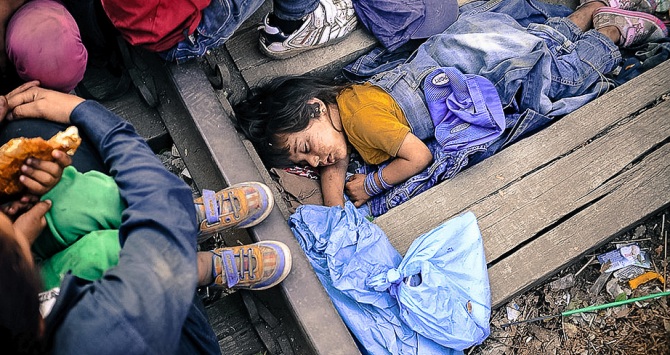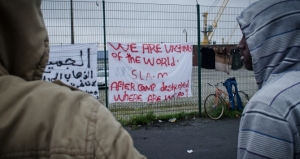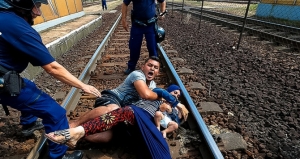Ruben Andersson, postdoctoral research fellow at the LSE’s Civil Society and Human Security Research Unit and author of Illegality, Inc., wrote the following post for Border Criminologies, University of Oxford.
 In southern Spain, a razor-wire manufacturer packs coils of gleaming, sharp-bladed ‘concertina’ wire and ships it to Hungary, where it adorns a new border fence erected to halt refugees’ onward movement into the EU. In the Mediterranean, an EU naval operation revs into second gear as the continent’s military forces prepare to board, seize, and destroy the boats carrying escapees from Libya’s vicious conflict. Further south, in Niger’s crossroads town of Agadez at the edge of the Sahara, more money is poured into European security efforts at halting migration while new, harsh laws against smuggling are failing to keep people at bay. Less than two months have passed since the picture of a dead boy, afloat in Turkish waters, rekindled solidarity with refugees across Europe―and yet the continent’s leaders are again coalescing around their time-honed attempt to ‘secure the borders’ and ‘fight illegal migration’ at any cost, whether human, political, or financial.
In southern Spain, a razor-wire manufacturer packs coils of gleaming, sharp-bladed ‘concertina’ wire and ships it to Hungary, where it adorns a new border fence erected to halt refugees’ onward movement into the EU. In the Mediterranean, an EU naval operation revs into second gear as the continent’s military forces prepare to board, seize, and destroy the boats carrying escapees from Libya’s vicious conflict. Further south, in Niger’s crossroads town of Agadez at the edge of the Sahara, more money is poured into European security efforts at halting migration while new, harsh laws against smuggling are failing to keep people at bay. Less than two months have passed since the picture of a dead boy, afloat in Turkish waters, rekindled solidarity with refugees across Europe―and yet the continent’s leaders are again coalescing around their time-honed attempt to ‘secure the borders’ and ‘fight illegal migration’ at any cost, whether human, political, or financial.
The panicked political debates on the ‘refugee crisis’ this summer have displayed a fair bit of amnesia, as if our shores had suddenly been hit by an unforeseen natural disaster: a ‘tide’ or ‘flood,’ in media jargon. In fact, European leaders should have been well-prepared for the spike in arrivals, and not just because the Syria conflict has kept festering while UN humanitarian efforts for refugees have remained vastly underfunded. In fact, Europe has seen successive ‘border crises’ over well more than a decade now, including the first large arrivals of sub-Saharan Africans into Italy in the early 2000s, the Spanish Canary Islands ‘boat crisis’ of 2006, and numerous ‘emergencies’ announced ever since. Each crisis has spawned more investment in border security, which has in turn worsened the problem by displacing routes, triggering more risky entry methods, and feeding the smuggling networks facilitating entry via those riskier methods and routes. We face a vicious cycle at the borders where the failure of controls feeds a demand for ever more controls: a cycle where many powerful groups stand to gain, while border crossers face ever graver risks to their safety.

In my own ethnographic research on European border controls, I’ve called the various sectors with a stake in the ‘fight against illegal migration’ an ‘illegality industry.’ This industry is the topic of an upcoming week of blog posts on Border Criminologies, written by scholars who don’t necessarily use the same concept but who show the dangerous workings, tangled relationships, and self-reinforcing economies of border controls in a range of settings: from the streets of Tripoli and European defence contractor headquarters to humanitarian and privately-run sea rescue missions in the Mediterrean. As a final post on the migratory ‘corridor’ from South America via Mexico to the United States shows, the dire effects of border security are felt far beyond European shores. Just as migratory routes have globalised, so have our governments’ border security efforts, as similar surveillance technologies, barriers, and patrols are put in place from Ecuador and Arizona to Greece and beyond.
In using the term ‘industry’ in referring to the various sectors involved in controlling land and sea migration into Europe, I’ve sought to put focus on the profits and ‘products’ of border security, rather than simply its repressive aspects―important as these are, particularly at a time when record numbers have been dying at the gates of Europe. Indeed, as other scholars similarly deploying the ‘industry’ term have asserted, migration―and migration controls―are now big business. This business is explored in the second post of this series by Martin Lemberg-Pedersen in his report on the collaborations among politicians, security forces, and defence contractors at the core of Europe’s border security response. In publicly-funded border controls, European defence groups have found a potential goldmine, with increasing sums poured into research and development for new security technologies. While these technologies, as I have recently shown elsewhere, don’t really ‘work’ in halting migration, they do something else, as Martin pinpoints: they create lock-in effects for more of the same type of ‘solution,’ making it harder and harder to see beyond the security frame around migration.
Migrants and refugees themselves are often the first to point out that someone, somewhere, is making a killing out of their misfortune. In the third post of the series about a danger-filled Tripoli, Marthe Achtnich reports on how migrants taken into Libyan detention feel they are ‘goods’ passed around in the ‘market’ of controls. This involves paying steep ‘liberation fees’ to guards in Libya’s derelict detention centres that stand as cruel museums to the Gaddafi era and the dictator’s close border security collaboration with Italy and the EU. In my own research, migrants and deportees voiced similar criticism of illicit gains. ‘Illegal migration has lots of money,’ was how one deported Senegalese boat migrant put it to me as we watched Spanish and African forces patrolling Senegal’s territorial waters off his seaside neighbourhood; other migrants I met on the clandestine trails called their prolonged confinement in Spanish reception centres a form of ‘human trading,’ or branded efforts at containing or patrolling them in Morocco, Mali or Spain a ‘business’ of the most sordid kind.

As the Libya and Senegal examples show, Europe’s border security response has for years involved ‘offshoring’ (or ‘externalising’) controls into non-EU space. Like the international value chain for the production of cheap consumer goods, the ‘illegality industry’ works on its human ‘goods’ across a dispersed geographical site, involving a bewildering array of sectors. The industry’s ‘outsourcing’ efforts involve not only offshore security forces, but also humanitarian organisations, NGOs, and private outfits collaborating closely with the policing response, whether in reception, detention, deportation, or on the open seas. Lorenzo Pezzani and Charles Heller, in the blog series’ fourth post, show how European authorities’ partial withdrawal from full humanitarian responsibilities has piled pressure on private shipping companies off Libyan coasts to carry out risky rescues. Next, Polly Pallister-Wilkins explores how one of the most independent-minded humanitarian organisations, Médecins Sans Frontières (MSF), has entered the fray of sea rescues―and so found itself in a delicate balancing act of engaging with border guards and their category of migrant ‘illegality,’ which keeps shaping the official response at the sea borders of Europe as well as the experience of those who cross.
The ‘industry’ of controls in Europe, then, is productive: it generates large rewards as well as new technologies, social relations, border realities, and roles for migrants and border workers―with distressing consequences, as we see in the tightly packed boats, newly erected fences, and detention centres characteristic of Europe’s failed ‘fight against migration.’ The series’ final contributor, Soledad Alvarez Velasco, shows how punitive border controls work in a similarly distressing manner in another region: the vast migratory hinterland of the United States. For migrants starting their US-bound journeys as far south as Ecuador, a violent ‘zone of transit’ now stretches ahead of them through Central America and Mexico. As in Europe, efforts to ‘halt migration’ have here created new, violent border zones and riskier entry methods, which serve to reinforce the security response even further.
Academically, we need to keep tracing the workings of this self-perpetuating industry―along with migrants’ and non-state actors’ role in it―and so help lay bare a system that has until now (with some notable exceptions) escaped sustained media scrutiny or public debate. Politically speaking, we need more such scrutiny and accountability in order to pave the way for a potential shift of course. It’s high time that Europe’s spectacularly failed efforts to ‘combat migration’ are properly accounted for, along with the intricate webs of connection linking up actors in the borderlands. This series’ contributors, to be sure, take important steps in precisely that direction.
If you enjoyed this post, contact us by email, or leave a comment below, on Facebook, or on Twitter.
Related Posts
   |





